A Long-Term Power Supply Risk Evaluation Method for China Regional Power System Based on Probabilistic Production Simulation
Abstract
1. Introduction
2. Long-Term Power-Supply Risk Evaluation Method
2.1. General Analysis of Extreme Weather Risks to Power Supply in China
2.2. The Overall Structure of the Probabilistic Production Simulation-Based Long-Term Power-Supply Risk Evaluation Method
3. High-Risk Extreme Weather Scenario Generation Method for Power Supply
3.1. Probabilistic Model of Extreme Weather Events Based on Copula Function
3.2. High-Risk Scenario Generation for Power Supply Based on Monte Carlo Simulation
4. Probabilistic Production Simulation Method
4.1. The Randomness of Power Sources and Load Regulation under Extreme Weather Events
4.2. The Production Simulation of Flexible Resources
4.3. Cross-Regional Power Transmission
5. Power Security Evaluation Based on Probabilistic Method
5.1. The Power Security Index System
5.2. The Probabilistic-Based Risk Evaluation Method
6. Case Study
6.1. The Production Simulation Results under Extreme Events
6.2. Probabilistic Analysis of Power Security under Extreme Events
7. Conclusions
- (1)
- The proposed scenario generation method can simulate different weather events through appropriate Copula function selection and related parameter regulation. And, the generated power supply risk scenarios provide basic information for random power input regulation under extreme events, revealing the power shortage level during long-term power transformation under specific extreme weather events.
- (2)
- The power production simulation method constructed in this study considers the influence of extreme weather on random power sources. The higher penetration of renewable energies deteriorates the system’s power regulation ability with more unbalanced power, while power curtailment also grows due to having insufficient flexible sources.
- (3)
- The case study of Yunnan’s power system showed that the main power shortage threat is drought, which decreases the power output of the dominant power source: hydropower plants. Meanwhile, the power shortages will overall grow with the retirement of fossil fuel plants, while energy storage will play a critical role in future power supply under extreme weather events, especially long-duration energy storage.
- (4)
- Compared with the power transformation scheme involving fossil fuel power plant life extension, in scheme 3, which involves larger cross-regional power capacity, can significantly reduce the LOLE and TOLE under different extreme weather scenarios. The case also validated that even large sending-end power systems will experience power shortages under extreme weather events, and power support from other regions will be a more cost-efficient and environmentally friendly method compared with retaining more fossil fuel power plants, as the construction and maintenance costs of power transmission lines is lower than that of extending the life of fossil fuel power plants.
- (1)
- Due to the frequency of the occurrence of extreme weather being affected by multiple factors, such as natural climate patterns, greenhouse gas emissions, atmospheric circulation, land use changes and so on, more studies should be carried out to investigate the influence of climate on power systems with high renewable penetration. In China, the regional power systems most likely to be affected are the northwestern power system, which has high penetration of renewables, and the southwestern power system, which is dominated by hydropower, such as those in Yunnan and Sichuan provinces.
- (2)
- The proposed extreme weather scenario generation method can be extended to more complicated scenarios, such as long-term drought and low-wind weather, which can cause larger power shortages due to low power output of hydropower and wind power. Meanwhile, Copula functions can also be replicated using a mixed Copula function, which can increase the accuracy of the results. It is noteworthy that the accuracy of the proposed method is high, which is related to the data quality, and high-spatiotemporal-resolution weather data, such as GIS data, would be preferred to improve the evaluation quality.
- (3)
- If the proposed method is applied to smaller-area power systems, more constraints should be considered, such as unit commitment, availability of units, power source ramping capability, and power grid congestion. Power grid congestion could be the most difficult constraint, due to the status of each power transmission line being strongly related to the power system’s operation status, and the increased randomness caused by the higher penetration of renewables would make the whole model more complicated to solve.
- (4)
- The simulation results indicated that cross-regional power interconnection is critical for the future power grid in China, and sending-end power system interconnection projects can ensure increased mutual aid among regions, such as between northwest and southwest China. The technical scheme is the key for transregional power system interconnection, which includes three main schemes: AC interconnection, HVDC interconnection based on line-commutated converters (LCCs), and HVDC interconnection based on voltage source converters. Further studies should be carried out for choosing the most cost-efficient interconnection scheme.
Author Contributions
Funding
Data Availability Statement
Conflicts of Interest
References
- Zhou, X.; Chen, S.; Lu, Z.; Huang, Y.; Ma, S.; Zhao, Q. Technology Features of the New Generation Power System in China. Proc. CSEE 2018, 38, 1893–1904+2205. [Google Scholar]
- National Energy Administration of the People’s Republic of China. Available online: http://www.nea.gov.cn/2023-05/25/c_1310721539.htm (accessed on 25 May 2023).
- Ghosh, S.; Younes, J.; Mohamed, S. Assessment of Bus Inertia to Enhance Dynamic Flexibility of Hybrid Power Systems with Renewable Energy Integration. IEEE Trans. Power Deliv. 2023, 38, 2372–2386. [Google Scholar] [CrossRef]
- Dai, H.; Su, Y.; Kuang, L.; Liu, J.; Gu, D.; Zou, C.; Huang, H. Contemplation on China’s Energy-Development Strategies and Initiatives in the Context of Its Carbon Neutrality Goal. Engineering 2021, 7, 1684–1687. [Google Scholar] [CrossRef]
- Xin, B.; Shan, B.; Li, Q.; Yan, H.; Wang, C. Rethinking of the “Three Elements of Energy” Toward Carbon Peak and Carbon Neutrality. Proc. CSEE 2022, 42, 3117–3125. [Google Scholar]
- Wu, D.; Milad, J.; John, N. A preliminary study of impact of reduced system inertia in a low-carbon power system. J. Mod. Power Syst. Clean Energy 2015, 3, 82–92. [Google Scholar] [CrossRef]
- Younesi, A.; Hossein, S.; Wang, Z.; Siano, P.; Mehrizi, A.; Safari, A. Trends in modern power systems resilience: State-of-the-art review. Renew. Sustain. Energy Rev. 2022, 162, 112397. [Google Scholar] [CrossRef]
- Shu, Y.; Tang, Y. Analysis and recommendations for the adaptability of China’s power system security and stability relevant standards. CSEE J. Power Energy Syst. 2017, 3, 334–339. [Google Scholar] [CrossRef]
- Yan, R.; Masood, N.; Saha, Y.; Bai, F.; Gu, H. The anatomy of the 2016 South Australia blackout: A catastrophic event in a high renewable network. IEEE Trans. Power Syst. 2018, 33, 5374–5388. [Google Scholar] [CrossRef]
- Yuan, P.; Zhang, Q.; Zhang, T.; Chi, C.; Gong, X. Analysis and enlightenment of the blackouts in Argentina and New York. In Proceedings of the 2019 Chinese Automation Congress (CAC), Hangzhou, China, 13 February 2020. [Google Scholar]
- Bialek, J. What does the GB power outage on 9 August 2019 tell us about the current state of decarbonised power systems? Energy Policy 2020, 146, 11821. [Google Scholar] [CrossRef]
- Zhang, L.; Chen, F.; Chen, K.; Zhang, K.; Chen, S.; Long, Z. A review on emergency response and recovery method for large area outage of power grid. In Proceedings of the 2022 IEEE 6th Information Technology and Mechatronics Engineering Conference (ITOEC), Chongqing, China, 4–6 March 2022; pp. 544–551. [Google Scholar]
- Hang, G.; Zhong, H.; Tan, Z.; Cheng, T.; Xia, Q.; Kang, C. Texas electric power crisis of 2021 warns of a new blackout mechanism. CSEE J. Power Energy Syst. 2022, 8, 1–9. [Google Scholar]
- Wang, G.; Dong, Y.; Xu, T.; He, J.; Zhang, Y. Analysis and Lessons of Brazil Blackout Event on August 15, 2023. 5. Proc. CSEE 2023, 43, 9461–9469. [Google Scholar]
- Gao, H.; Guo, M.; Liu, J.; Liu, J.; He, S. Power Supply Challenges and Prospects in New-generation Power System from Sichuan Electricity Curtailment Events Caused by High-temperature Drought Weather. Proc. CSEE 2023, 43, 4517–4538. [Google Scholar]
- Hu, Y.; Xue, S.; Zhang, H.; Zhang, H.; Feng, X.; Tang, C.; Lin, Y.; Zheng, P. Cause Analysis and Enlightenment of Global Blackouts in the Past 30 Years. Electr. Power 2021, 54, 204–210. [Google Scholar]
- Zhang, Y.; Zhang, J.; Han, X.; Jin, X.; Xie, G.; Zhu, R. Analysis of Power Shortage in India and Enlightenment on Power Gird Development. In Proceedings of the 2022 IEEE/IAS Industrial and Commercial Power System Asia (I&CPS Asia), Shanghai, China, 13 November 2022. [Google Scholar]
- Cuartas, L.A.; Cunha, A.P.M.d.A.; Alves, J.A.; Parra, L.M.P.; Deusdará-Leal, K.; Costa, L.C.O.; Molina, R.D.; Amore, D.; Broedel, E.; Seluchi, M.E.; et al. Recent hydrological droughts in Brazil and their impact on hydropower generation. Water 2022, 14, 601. [Google Scholar] [CrossRef]
- Valasai, G.; Uqaili, M.; Memon, H.; Samoo, S.; Mirjat, N.; Harijan, K. Overcoming electricity crisis in Pakistan: A review of sustainable electricity options. Renew. Sustain. Energy Rev. 2017, 72, 734–745. [Google Scholar] [CrossRef]
- Gohli, H. High-voltage steering: China’s energy market reforms, industrial policy tools and the 2021 electricity crisis. Energy Res. Soc. Sci. 2022, 93, 102851. [Google Scholar] [CrossRef]
- Shen, J.; Cheng, C.; Jia, Z.; Zhang, Y.; Lv, Q.; Cai, H.; Wang, B.; Xie, M. Impacts, challenges and suggestions of the electricity market for hydro-dominated power systems in China. Renew. Energy 2022, 187, 743–759. [Google Scholar] [CrossRef]
- Li, D.; Liu, Z.; He, J.; He, L.; Ye, Z.; Liu, Z. Renewable Energy Real-Time Carrying Capacity Assessment Method and Response Strategy under Typhoon Weather. Energies 2024, 17, 1401. [Google Scholar] [CrossRef]
- Rao, H.; Han, F.; Chen, Z.; Huang, G.; Wang, D.; Zhang, Y.; Cai, W.; Xu, M.; Jiang, W.; Zhou, B. Strategy for Guaranteeing Power Supply Security of China. Strateg. Study CAE 2023, 25, 100–110. [Google Scholar]
- Shan, B.; Ji, X.; Xu, C.; Liu, Z. Evolving Tendency of Electric Supply and Demand Pattern under the Circumstances of High-Quality Energy Development. Electr. Power 2021, 54, 1–9+18. [Google Scholar]
- Dong, J.; Chen, Z.; Dou, X. The Influence of Multiple Types of Flexible Resources on the Flexibility of Power System in Northwest China. Sustainability 2022, 14, 11617. [Google Scholar] [CrossRef]
- Zhou, Y.; Wei, T.; Chen, S.; Wang, S.; Qiu, R. Pathways to a more efficient and cleaner energy system in Guangdong-Hong Kong-Macao Greater Bay Area: A system-based simulation during 2015–2035. Resour. Conserv. Recycl. 2021, 174, 105835. [Google Scholar] [CrossRef]
- Chen, X.; Liu, Y.; Wang, Q.; Lv, J.; Wen, J.; Chen, X.; Kang, C.; Cheng, S.; Micael, B. Pathway toward carbon-neutral electrical systems in China by mid-century with negative CO2 abatement costs informed by high-resolution modeling. Joule 2022, 5, 2715–2741. [Google Scholar] [CrossRef]
- Zhuo, Z.; Du, E.; Zhang, N.; Chris, P.; Lu, X.; Xiao, J.; Wu, J.; Kang, C. Cost increase in the electricity supply to achieve carbon neutrality in China. Nat. Commun. 2022, 13, 3172. [Google Scholar] [CrossRef] [PubMed]
- Do, V.; McBrien, H.; Flores, N.M.; Northrop, A.J.; Schlegelmilch, J.; Kiang, M.; Casey, J. Spatiotemporal distribution of power outages with climate events and social vulnerability in the USA. Nat. Commun. 2023, 14, 2470. [Google Scholar] [CrossRef]
- Aoun, A.; Adda, M.; Ilinca, A.; Ghandour, M.; Ibrahim, H. Centralized vs. Decentralized electric grid resilience analysis using Leontief’s input–output model. Energies 2024, 17, 1321. [Google Scholar] [CrossRef]
- Lu, Z.; Li, H.; Qiao, Y. Power System Flexibility Planning and Challenges Considering High Renewable Energy. Autom. Electr. Power Syst. 2016, 40, 147–158. [Google Scholar]
- Ciapessoni, E.; Cirio, D.; Pitto, A.; Marcacci, P.; Lacavalla, M.; Massucco, S.; Silvestro, F.; Sforna, M. A Risk-Based Methodology and Tool Combining Threat Analysis and Power System Security. Energies 2018, 11, 83. [Google Scholar] [CrossRef]
- Liu, Z.; Tang, P.; Hou, K.; Zhu, L.; Zhao, J.; Jia, H.; Pei, W. A Lagrange-Multiplier-Based Reliability Assessment for Power Systems Considering Topology and Injection Uncertainties. IEEE Trans. Power Syst. 2024, 39, 1178–1189. [Google Scholar] [CrossRef]
- Yang, Y.; Li, Z.; Mandapaka, P.; Lo, E. Risk-averse restoration of coupled power and water systems with small pumped-hydro storage and stochastic rooftop renewables. Appl. Energy 2023, 339, 120953. [Google Scholar] [CrossRef]
- Stover, O.; Karve, P.; Mahadevan, S. Reliability and risk metrics to assess operational adequacy and flexibility of power grids. Reliab. Eng. Syst. Saf. 2023, 231, 109018. [Google Scholar] [CrossRef]
- Li, H.; Jiang, Y.; Song, T.; Liu, Z.; Xia, K.; Chen, Z.; Shi, R. Research on the Characteristics of Power Supply and Demand Balance and Supply Guarantee Strategies in the Context of New Power Systems. Power Syst. Clean Energy 2023, 39, 72–78. [Google Scholar]
- Nelsen, R.B. An Introduction to Copulas; Springer: New York, NY, USA, 1999. [Google Scholar]
- Sklar, A. Fonctions de répartition à n dimensions et leurs marges. Publ. Inst. Statist. Univ. 1959, 8, 229–231. [Google Scholar]
- Wu, X.; Wu, Y.; Cheng, X.; Cheng, C.; Li, Z.; Wu, Y. A mixed-integer linear programming model for hydro unit commitment considering operation constraint priorities. Renew. Energy 2023, 204, 507–520. [Google Scholar] [CrossRef]
- Weng, X.; Jiang, C.; Yuan, M.; Zhang, M.; Zeng, T.; Jin, C. An ecologically dispatch strategy using environmental flows for a cascade multi-sluice system: A case study of the Yongjiang River Basin, China. Ecol. Indic. 2021, 121, 107053. [Google Scholar] [CrossRef]
- He, Z.; Yang, J.; Wu, Y.; Han, C.; Lu, H.; Dong, A. Investigation on the future AC and DC combined operation form and development trend under energy transition. Proc. CSEE 2023, 43, 99–113. [Google Scholar]
- Liu, Z.; Zhou, B.; Li, X.; Meng, J.; Yu, X. The Study on Interconnection of Northwest and Southwest Power Grid in China. J. Glob. Energy Interconnect. 2023, 6, 341–352. [Google Scholar]
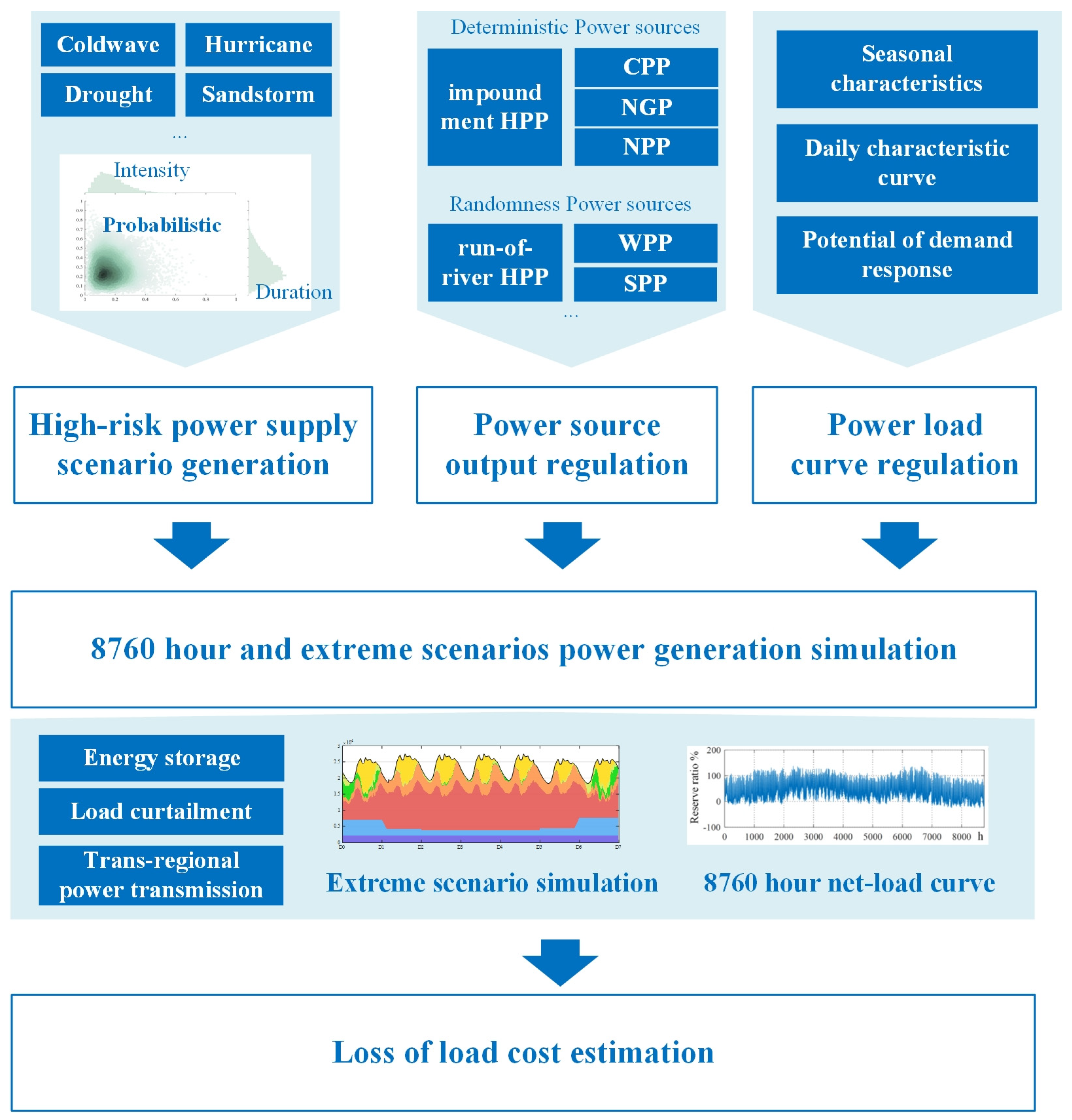



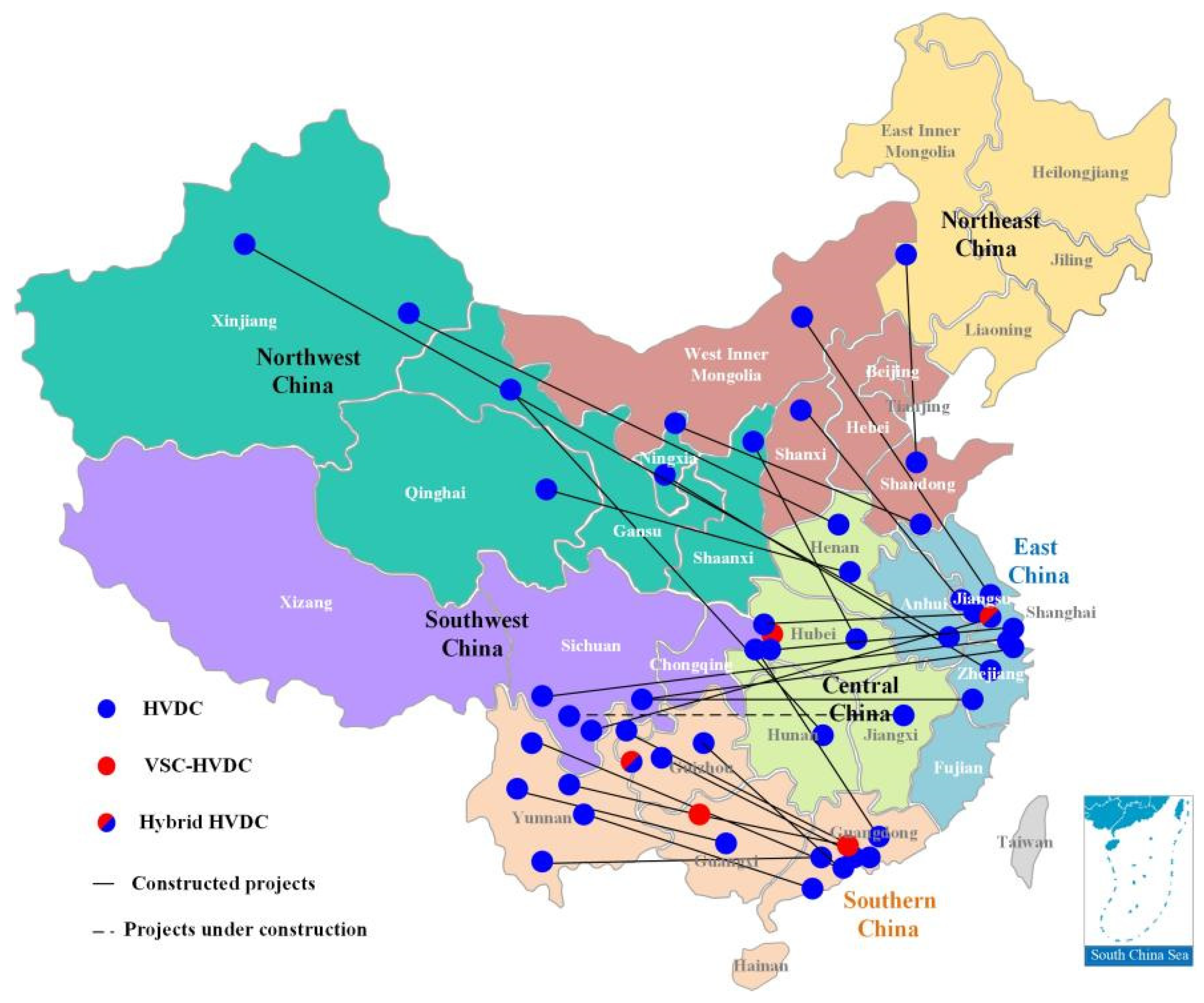
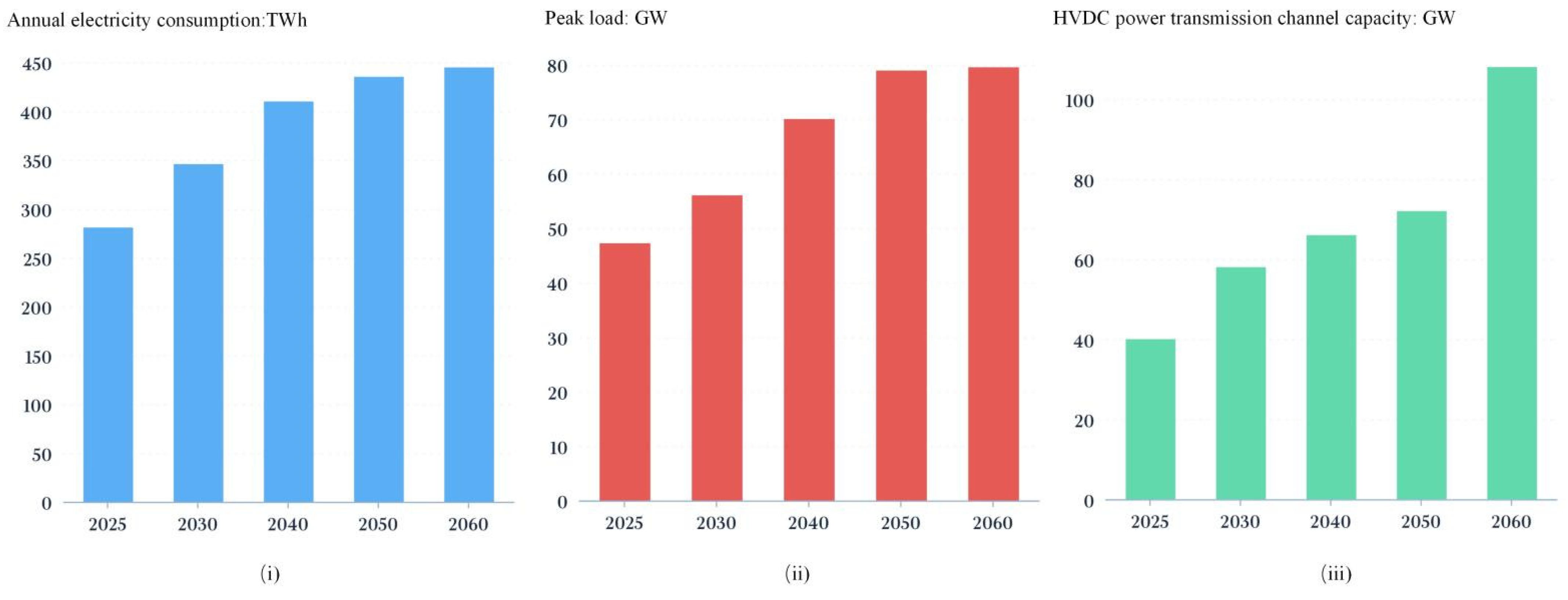



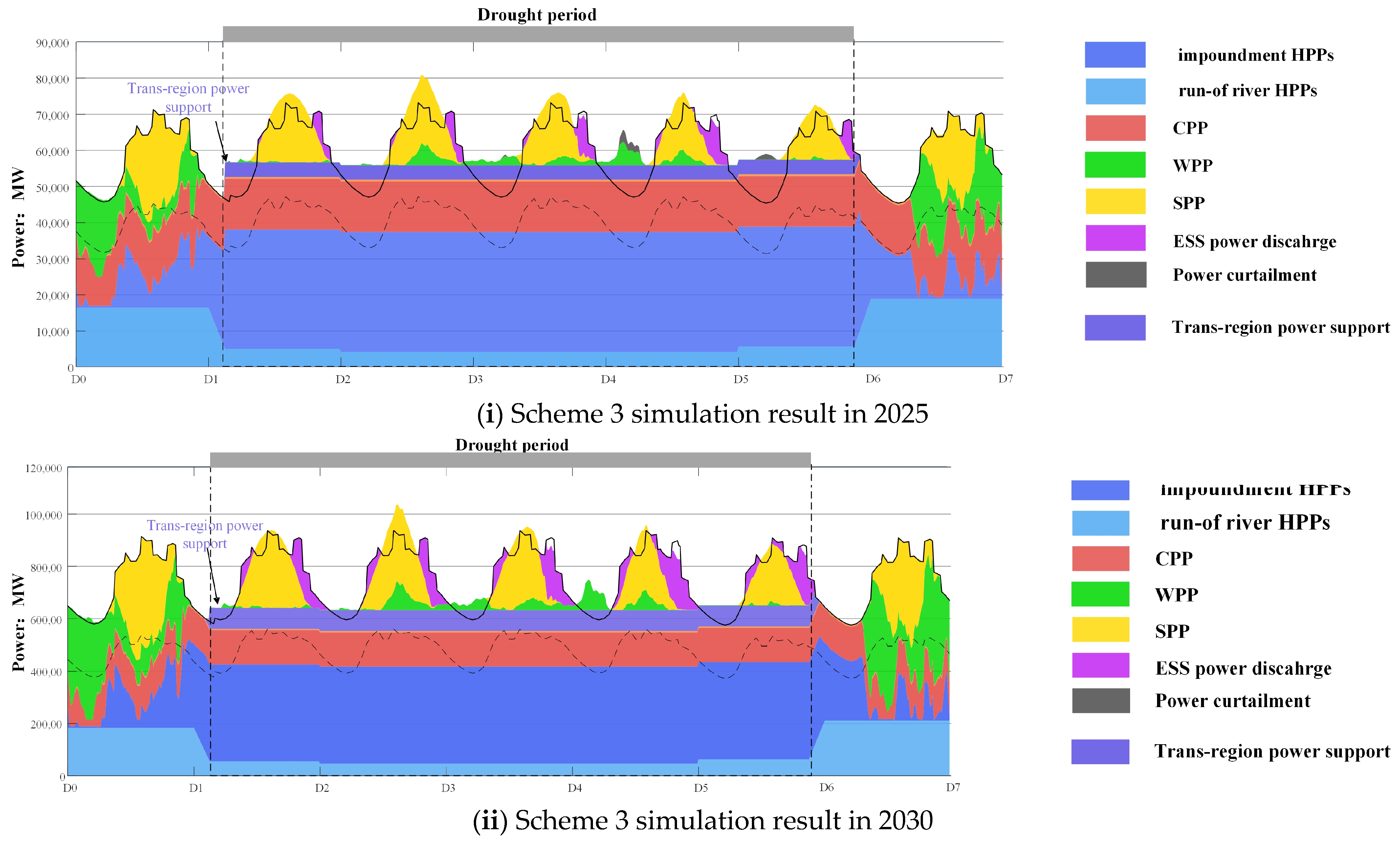



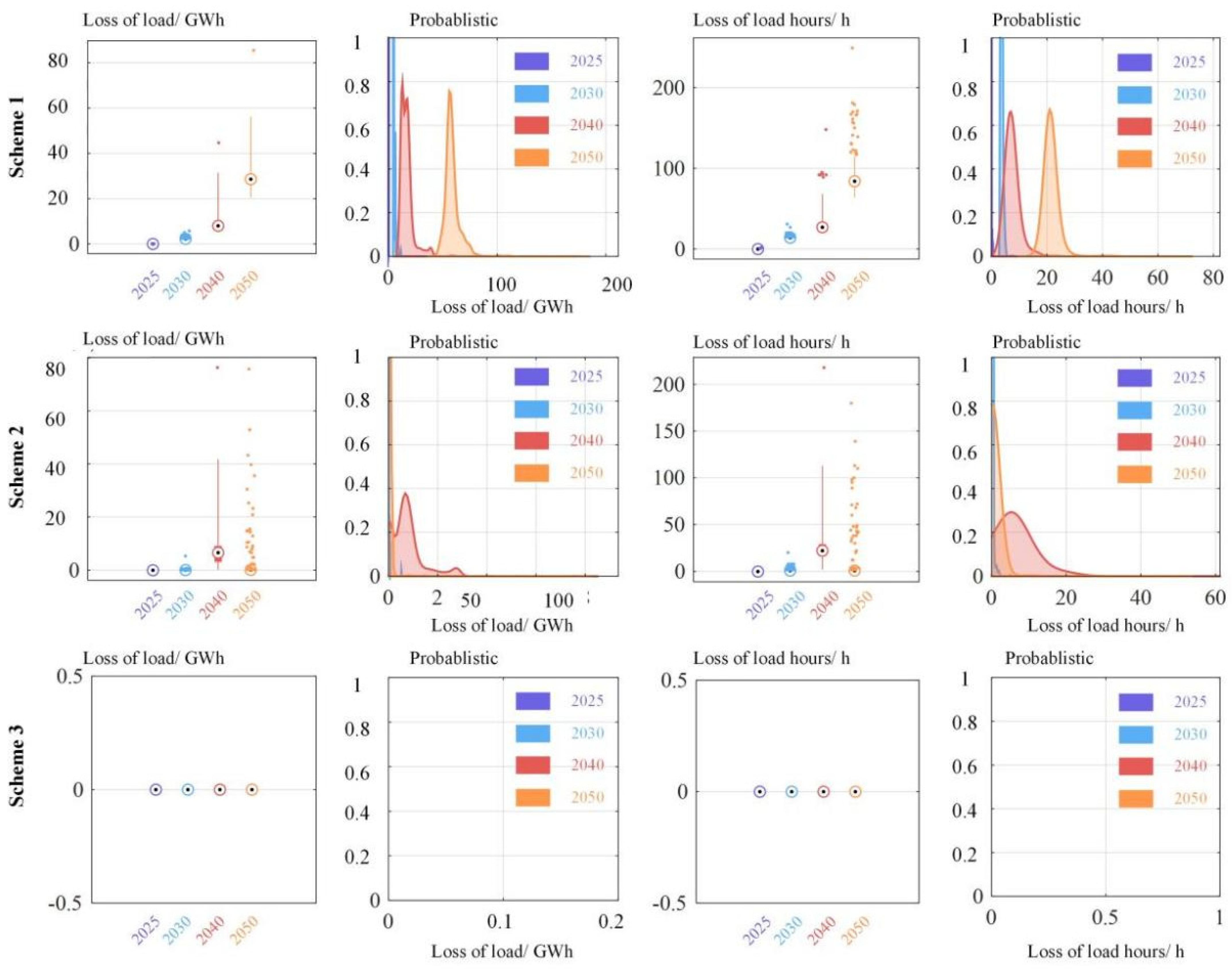
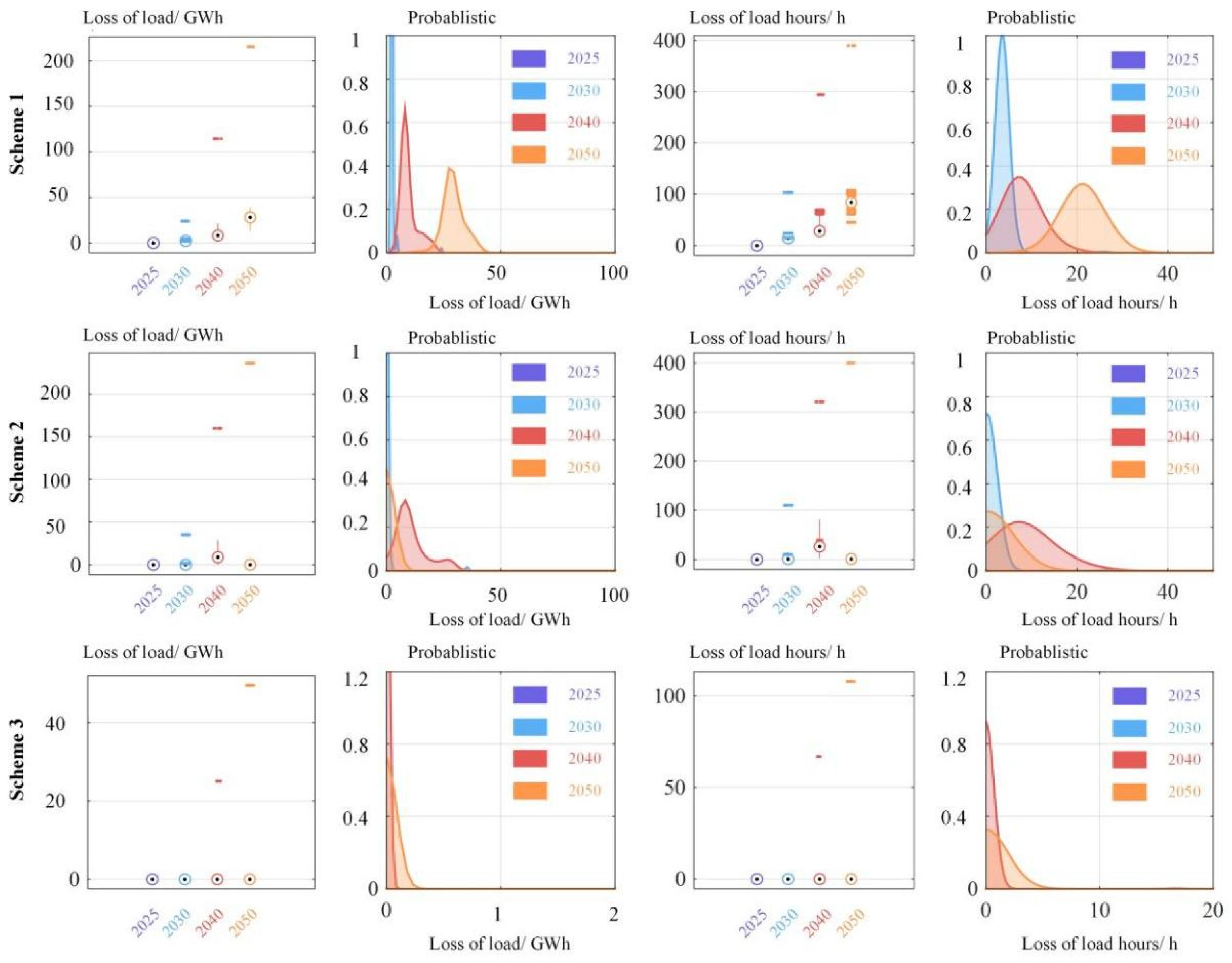
| High-Risk Areas | Possible Occurrence Times | |
|---|---|---|
| Cold wave | All areas | Late fall, winter, and the beginning of spring |
| Drought | All areas | Higher possibility in spring in northern areas Higher possibility in summer and fall in Yangtze River downstream area |
| Rainstorm | East and South China | Higher possibility in summer half-year in southern areas |
| Sand storm | Northwest and North China | Spring |
| Hurricane | East and South China | From late spring to the beginning of winter, high possibility from July to September |
| Cold Wave | Drought | Rain Storm | Sand storm | Hurricane | |
|---|---|---|---|---|---|
| Copula function | Gumbel | Gumbel | t | t | Clayton |
| Type of Resources | Regulation Range | Ramp Rate | Typical Unit Capacity | Start-Up Time | Current Scale | |
|---|---|---|---|---|---|---|
| Unit | % | % Pn/min | MW | Hour | GW | |
| CPP | before | 50~100 | 1~2 | 200~1000 | 6~10 | >550 |
| after | 30~100 | 3~6 | 4~5 | >100 | ||
| CHP-CPP | before | 80~100 | 1~2 | 220~330 | 6~10 | >370 |
| after | 50~100 | 3~6 | 4~5 | >80 | ||
| NGP | 20~100 | 8 | 50~700 | 2 | ≈120 | |
| HPP | 0~100 | 20 | 25~1000 | <1 | ≈360 | |
| NPP | 30~100 | 2.5~5 | 300~1750 | / | ≈55 | |
| HPS | −100~100 | 10~50 | 50~300 | <0.1 | ≈45 | |
| ESS | −100~100 | 100 | 10~2000 | <0.1 | ≈12 | |
| CAS | −100~100 | 30 | 20~300 | 0.1 | / | |
| HWE | 0~100 | / | 5~200 | / | / | |
| DR | 3~5% of the total load | 100~200 | / | 0 | ≈50 | |
| Type of Resource/GW | 2025 | 2030 | 2040 | 2050 | 2060 | |
|---|---|---|---|---|---|---|
| Scheme 1 | CPP | 11.6333 | 11.3883 | 11.046 | 6.909 | 3.92 |
| NGP | 0.5 | 1 | 2 | 2 | 2 | |
| HPP (without HPS) | 83 | 92.736 | 97.872 | 104.192 | 112.992 | |
| NPP | 0 | 0 | 0 | 0 | 0 | |
| WPP | 19.245 | 34.5 | 55.75 | 66.95 | 85.375 | |
| SPP | 23.5144 | 32.5 | 68.64 | 110.422 | 150.722 | |
| HPS | 4.5 | 7 | 9.5 | 10.5 | 11.5 | |
| ESS | 2 | 3.5 | 5 | 7 | 9 | |
| Scheme 2 | CPP | 11 | 10 | 8.5 | 5 | 3 |
| NGP | 0.5 | 0.5 | 0.5 | 0.5 | 0.5 | |
| HPP (without HPS) | 83 | 92.736 | 97.872 | 104.192 | 112.992 | |
| NPP | 0 | 0 | 0 | 0 | 0 | |
| WPP | 23.094 | 41.4 | 66.9 | 80.34 | 102.45 | |
| SPP | 28.21728 | 44 | 82.368 | 132.5064 | 180.8664 | |
| HPS | 6 | 10 | 14 | 16 | 16 | |
| ESS | 5 | 10 | 20 | 30 | 30 | |
| Scheme 3 | CPP | 11 | 10 | 8.5 | 5 | 3 |
| NGP | 0.5 | 0.5 | 0.5 | 0.5 | 0.5 | |
| HPP (without HPS) | 83 | 92.736 | 97.872 | 104.192 | 112.992 | |
| NPP | 0 | 0 | 0 | 0 | 0 | |
| WPP | 21.99429 | 39.42857 | 63.71429 | 76.51429 | 97.57143 | |
| SPP | 26.8736 | 41.90476 | 78.44571 | 126.1966 | 172.2537 | |
| HPS | 5.71 | 9.52 | 13.33 | 15.24 | 15.24 | |
| ESS | 4.76 | 9.52 | 19.05 | 28.57 | 28.57 | |
| Cross-region power capacity | 4 | 8 | 12 | 16 | 16 | |
Disclaimer/Publisher’s Note: The statements, opinions and data contained in all publications are solely those of the individual author(s) and contributor(s) and not of MDPI and/or the editor(s). MDPI and/or the editor(s) disclaim responsibility for any injury to people or property resulting from any ideas, methods, instructions or products referred to in the content. |
© 2024 by the authors. Licensee MDPI, Basel, Switzerland. This article is an open access article distributed under the terms and conditions of the Creative Commons Attribution (CC BY) license (https://creativecommons.org/licenses/by/4.0/).
Share and Cite
Hu, J.; Wang, Y.; Cheng, F.; Shi, H. A Long-Term Power Supply Risk Evaluation Method for China Regional Power System Based on Probabilistic Production Simulation. Energies 2024, 17, 2515. https://doi.org/10.3390/en17112515
Hu J, Wang Y, Cheng F, Shi H. A Long-Term Power Supply Risk Evaluation Method for China Regional Power System Based on Probabilistic Production Simulation. Energies. 2024; 17(11):2515. https://doi.org/10.3390/en17112515
Chicago/Turabian StyleHu, Jianzu, Yuefeng Wang, Fan Cheng, and Hanqing Shi. 2024. "A Long-Term Power Supply Risk Evaluation Method for China Regional Power System Based on Probabilistic Production Simulation" Energies 17, no. 11: 2515. https://doi.org/10.3390/en17112515
APA StyleHu, J., Wang, Y., Cheng, F., & Shi, H. (2024). A Long-Term Power Supply Risk Evaluation Method for China Regional Power System Based on Probabilistic Production Simulation. Energies, 17(11), 2515. https://doi.org/10.3390/en17112515







